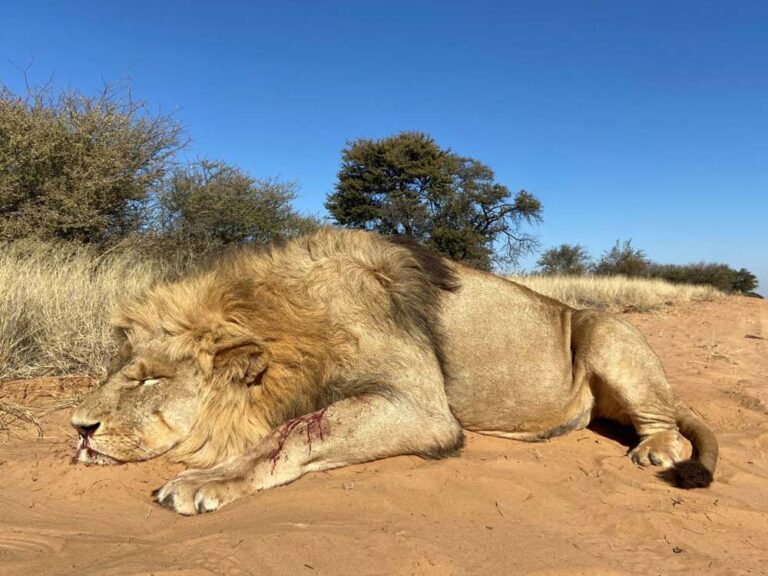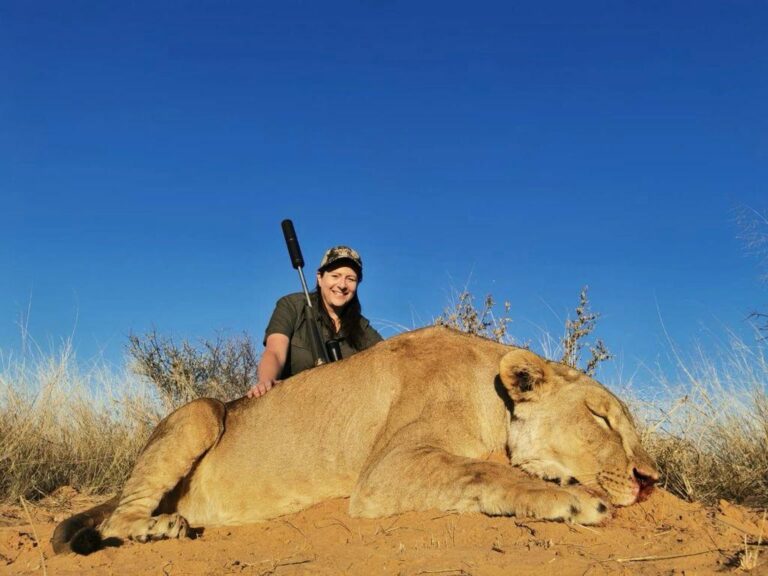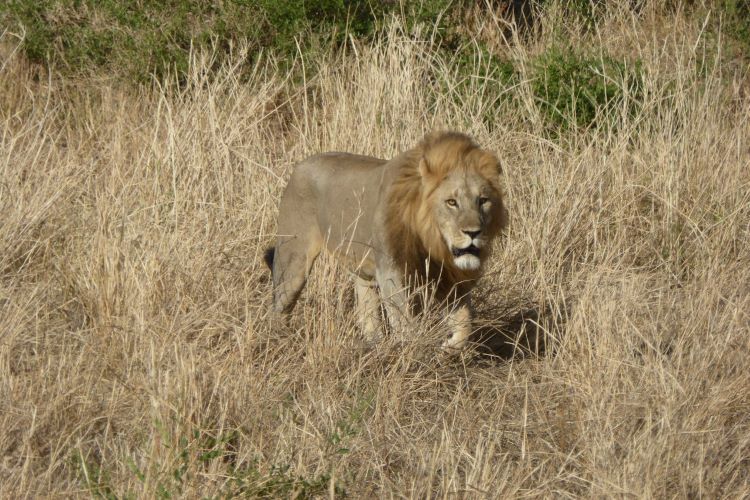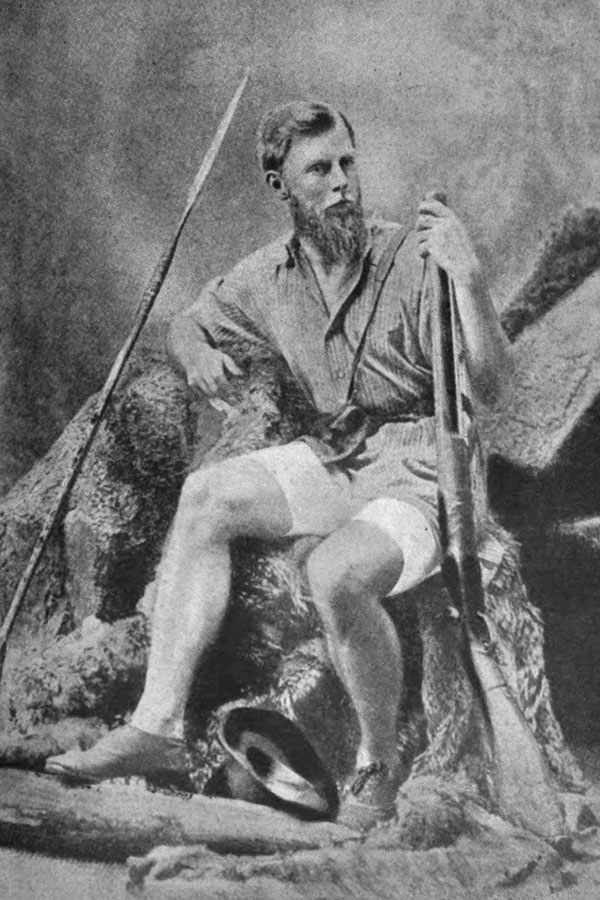Africa’s Lion hunting safari offerings are famous the world over for producing top-quality trophies, both from the early days of Africa’s game-hunting industry to the modern era. Lion hunting in Africa evokes a feeling of days long ago and brings the hunters face-to-face with one of the continent’s most revered big game animals.
But before booking your Lion safari hunt, how does one determine a lion’s trophy quality? What features arguably make the Lion Africa’s most recognizable animal, and how did the famed hunters of old stamp their authority on a budding industry that today is worth millions of Dollars?
[DYNAMIC-BLOGTABLEOFCONTENT]
Key Takeaways
- A quality Lion trophy isn’t just about size.
- Africa has been the choice destination for Lion hunting for centuries.
- Some of history’s most notable hunters cut their teeth trophy Lion hunting in Africa.
- Africa has multiple destinations for Lion hunting safari
- The mane argument may or may not have some truth to it.
- Spoiler alert – some African Lions don’t grow a mane at all…

What makes a good Lion Safari Hunting Trophy?
If Buffalos have bosses and Elephants have tusks, what do lions have? They have the size and a unique characteristic of the mane. But how do these things imply a good trophy and are there regulations to keep in mind?
Age
Male Lions are generally only considered “hunting targets” from the age of 6; at this age, they are fully grown and considered outside of their breeding prime. By now, their manes are also fully grown and they’ve reached the full adult size.
Size
When it comes to the SCI, a skull measurement minimum of 23 inches is required for any potential record book additions. When looking at their body size, Lions are second only to Tigers in terms of size and mass. Grown males average between 70 and 80+ inches in body length, while females come in from around 60 to 73 inches. The bigger the target, the grander the trophy, especially if the hunter is looking for a shoulder or full mount.
Mane
The hallmark of Africa’s male Lions; the mane is considered the main feature to look for when Lion hunting in Africa. A Lion’s mane can vary from brown-blonde to reddish and even black, with some colors holding more importance than others.
Gender
Males make up the bulk of Lion hunting safari trophies as some destinations don’t allow the hunting of female Lions; males also carry the distinct mane. Don’t underestimate Lionesses however, as they are known to be more aggressive than their male counterparts, so too can they become an even more challenging and thrilling hunt if available.

Black vs Blonde: A big Trophy Lion Hunting Debate or a Matter of Opinion?
The mane is the King of the Jungle’s crowning glory, and the Lion safari hunt wouldn’t have the same attraction if it weren’t for that crown. Within African folklore, the Lion, and by extension its mane, are seen as symbols of masculinity, leadership, power, and strength. Kings, chiefs, and tribal leaders have adorned themselves in Lion pelts as a symbol of their rule and character. The Lion is also seen as a spiritual totem of protection, courage, and ancestral power and guidance.
What’s the purpose of a Lion’s mane?
Scientists and animal experts alike have debated the purpose of a Lion’s mane for several hundred years. Theories include the idea that it serves as armor, protecting the animal’s neck and throat from injury during fights for territory and mating. In contrast, others speculate it’s a way for Lions to regulate their body temperature.
The commonly accepted theory is that the mane is a symbol of genetics, fighting ability, and breeding strength. Studies have shown that the bigger and darker the mane, the more attraction a male receives from the opposite sex.
What’s Mane Color got to do with it?
Blondes may have more fun, but in Lions, those with the darker mane are seen as the top specimen. Testing has shown that darker or black-maned Lions have slightly elevated levels of testosterone; these lions are also known to have eaten better during the year. Dark-maned decoy lions were placed in areas of the study, and it was shown that the lionesses tend to prefer darker-haired males. Whether they’re seen as healthier breeding stock or having better genetics is up for discussion.
How does Mane Color affect Lions?
Black-maned males can be affected in a similar way to us humans when wearing dark clothing on a hot day. The color attracts heat, while the actual hairs, which are thicker and denser, retain the heat for longer. Lions don’t sweat, and their primary way to regulate body temperature comes from bodily radiation and breathing (or panting). Having a dark, long mane reduces the surface area available for regulating body heat, while coincidentally trapping heat around the animal’s organs and face, causing heat stress and likely some irritation.
Mane length – “Regular Lions” vs the Bald Lions of Tsavo
Kenya’s Tsavo National Park is home to a sub-group of Lions famous for having little to no mane at all. The working theory is that due to the region’s extreme heat and dry environment, these Lions adapted by shedding their manes. This lack of a mane helps them to regulate their body temperature and cool off at a much faster rate than their maned cousins. The lack of a mane could also contribute to the Lion’s hunting abilities, helping them move through the area without becoming snagged and entangled in the region’s thorny and thick vegetation. Some have speculated a genetic difference between these Lions and those in other hot, arid regions as these different groups still grow a mane, while those in Tsavo grow little to none.
So what about the testosterone and mane growth relationship? It seems evolution or better yet necessity, has been championed over vanity in the Tsavo region, where the lack of a mane is probably essential to survival.

Famous Historical Figures of the Lion Hunting Safari
Lion hunting in Africa has some of history’s most renowned hunters in its story. Trophy Lion hunting was (and still is) one of Africa’s most popular big game industry activities contributing hundreds of millions of dollars to the country’s economy with the lion safari hunt sector bringing in its fair share of the tally.
Lion hunts of old were mainly about European and American hunters staking their claim on Africa’s plains and writing their names in notoriety. Quantity and quality went hand in hand, and back before the invention of today’s technologies, they made it work.
Yank Allen
The former Texan cowboy arrived in South Africa around 1900 and went on to become a professional hunter who commonly served the farming communities. He was hired and paid to protect livestock and transport operations. One of the earliest American hunters in Africa, Yank was known to hold Lions in low regard and preferred to hunt on solo trips. During his time in then Rhodesia and southern Africa, it was estimated that Yank Allen was responsible for around 300 Lion kills.
Roualeyn Gordon-Cumming
Nicknamed “The Lion Hunter,” Roualeyn’s time in Africa began in 1843. His safaris for Lion hunting in Africa were usually focused on the present-day Limpopo region, where he targeted the King of the Jungle, alongside other big game such as Elephant, Giraffe, Hippo, and a long list of African antelopes. Apart from being a skilled hunter, Roualeyn was also known for always wearing a kilt (he was a Scot after all!) and hunting alongside his trusted hounds on horseback.
Ernest Hemingway
Immersing yourself in the subject is a great way to ensure success in a literary project, and Mr. Hemingway himself did that all too well. The renowned author undertook two significant hunting safaris in Africa, the first in 1933 and the other in 1953. These hunts targeted numerous big game species across Kenya, Tanzania (then Tanganyika), Rwanda, and the Congo. Trophy Lion hunting was on the cards both for Hemingway’s hunts and certain publications such as “The Short Happy Life of Francis Macomber” and “The Green Hills of Africa.” Ernest’s hunting trips, apart from the trophies, focused on his enjoyment of experiencing the natural world and ensuring accurate depictions of the landscape in his books.
W.D.M. “Karamojo” Bell
Walter Dalrymple Maitland Bell owes the nickname “Karamojo” to his time spent in Uganda’s Karamojo region, where his many Lion hunting safari served as both preparation and protection while the Ugandan Railway was built. Arriving in Africa around 1896 and later serving in the Boer War Walter’s many hunting expeditions targeted various trophy species. However, his tally of 25 Lions is probably the most famous of these. When not hunting the plains, Karamojo the man wrote many contributions to American hunting publications and authored books such as “Karamojo Safari”.
Theodore Roosevelt
The man behind what is perhaps the most famous Lion expedition of all American hunters, Theodore Roosevelt’s expedition of 1909 – 1910 saw the former American president recording a tally of 9 Lion trophies. One of these trophies made its way to the US Natural History Museum where it became a piece of the Smithsonian collection. Roosevelt himself described the animal as a “brute” and “savage.” Coincidentally, its mane was tinged with black.
Petrus Jacobs
Selous may have nicknamed Petrus Jacobs the leading Elephant hunter in Africa, but the late Boer was rumored to have shot over 100 Lions in his lifelong hunting career. One such lion safari hunt in his 70s saw Petrus being mauled by a resilient target, but being saved by his pack of hunting dogs, who fended off the rogue Lion. The hunter was known for taking shots from horseback but also enjoyed pursuing his big game targets on foot.
Frederick Selous
No list of great hunters would be complete without mention of Mr. Selous. While his hunting career was mainly focused on Elephants, Frederick’s time in Africa recorded a trophy Lion count of over 30. His African legacy extends well into today, where Tanzania’s historic Selous Nature Reserve bears his name and allows others the opportunity to record their very own big cat glory through strictly controlled hunting practices. Many of Selous’ safaris molded the hunting trade into the industry it is today, inspiring hunters, guides, and entrepreneurs alike to venture deep into Africa’s wilderness and find the gems of its plains.

In Parting
With multiple destinations and packages available, you can pick the trophy Lion hunting package to suit your needs and wants. The tags allocated for Lion hunting safari change from year to year, and can sometimes be very limited. So book your space soon to see if a black maned beast is waiting for you.
Frequently Asked Questions
What areas are best for Lion hunting in Africa?
Africa is fortunate enough to have multiple destinations in which to plan a lion safari hunt. We’ve covered these in depth in other blogs on our site, simply search the destination or blog tabs for a full-length blog below.
- South Africa – Most Lion hunting in SA is carried out on large areas of private land, often larger than 15,000 acres. The country allows the hunting of both male and female Lions, and numbers are dependent on the tags issued by CITES.
- Namibia – Commonly practiced in the Caprivi region, Lion permits, and quotas can be limited or lower than other destinations due to the area’s smaller populations.
- Zimbabwe – Lion can be found across most hunting regions of the country and specific regulations will depend on the type of concession used. Baiting is considered the most common hunting method in the region, thanks to many watering holes and sites.
- Mozambique – A member of southern Africa’s tropical region, Mozambique allows Lion hunting at night with the use of artificial light. A practice that is not allowed in most destinations.
- Zambia – This hunting destination is renowned for its black-maned males, Zambia.
- Tanzania – The Masailand and Selous reserves have supplied record Lions over the years. Tanzania’s hunting regulations are some of the strictest on the continent, so be sure to familiarize yourself with their requirements.
Can I export my Lion Trophy?
American hunters looking to bring their big cat home must adhere to the stringent US Fish and Wildlife Service rules. As of 2025, trophies captured during a canned hunt MAY NOT be imported into the country. Generally, the exportation of a lion trophy will require CITES permits, special import and export papers, and documents regarding the “cleanliness” of the trophy, owing to potential bacteria and diseases that can be transmitted through animal skins.
What Firepower and Shot Placement do I need to prepare for?
The general firearm requirement across Africa is a .375, but hunters can choose to go heavier if they prefer. This caliber is believed to be the most effective and humane, ensuring a quicker kill and preventing the hunter from having to track down a wounded lion.
The broadside shot – this shot targets the heart and lungs, large organs with a much bigger area to target. The X mark for this shot is just behind the front leg, around the “elbow” joint region.
The front-facing shot – the Lion’s broad chest provides an ample target area for the hunter to make this shot, the focus is the meeting point between chin and neck. This shot also focuses on the heart and lungs.
Quartering towards – when facing the Lion at an angle, the bullseye point sits at the base of the neck and shoulder.
For a more in-depth assessment of shot placement for your next lion hunting safari, check out the shot placement for Lions guide from our site.
Do Lions require a special license?
Lions themselves don’t require a special permit; however, some destinations dictate that Lions may only be hunted on specific license lengths, such as the 21-day permit requirement for Tanzanian safaris.
